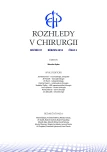Prediction of bowel damage in patients with gastroschisis
Authors:
B. Frýbová; A. Kokešová; R. Vlk; M. Rygl
Authors‘ workplace:
Klinika dětské chirurgie 2. lékařské fakulty Univerzity Karlovy a FN v Motole, Praha
Published in:
Rozhl. Chir., 2018, roč. 97, č. 3, s. 105-108.
Category:
Review
Overview
Introduction:
Gastroschisis is the most common malformation among abdominal wall defects with the incidence of 1:4−5000 live birth neonates. Postoperative care for these patients is very difficult due to the risk of abdominal compartment syndrome. The identification of markers that correlate with bowel damage in gastroschisis may prevent this serious postoperative complication.
Methods:
Review of the literature.
Conclusion:
Prenatal ultrasound prediction of bowel damage followed by an appropriate surgical strategy is a possibility of optimizing care and outcomes in gastroschisis patients. The dynamics of I-FABP is a promising biomarker for the elimination of abdominal compartment syndrome during postoperative care.
Key words:
gastroschisis − preformed silo − intraabdominal dilatation − I-FABP
Sources
Lap CC, Brizot ML, Pistorius LR, et al. Outcome of isolated gastroschisis; an international study, systematic review and meta-analysis. Early Hum Dev 2016;103:209−18.
2. Holcomb GW, Murphy JD, Ostlie DJ. Ashcraft‘s Pediatric Surgery, Elsevier 2014:660−72.
3. Pet GE, Stark RA, Meehan JJ, et al. Outcomes of bedside sutureless umbilical closure without endotracheal intubation for gastroschisis repair in surgical infants. Am J Surg 2017;213:958−62.
4. Bianchi A, Dickson AP. Elective delayed reduction and no anesthesia: ‚minimal intervention management‘ for gastrochisis. J Pediatr Surg 1998;33:1338−40.
5. Ross AR, Eaton S, Zani A, et al. The role of preformed silos in the management of infants with gastroschisis: a systematic review and meta-analysis. Pediatr Surg Int 2015;31:473−83.
6. Suominen PK, Pakarinen MP, Rautiainen P, et al. Comparison of direct and intravesical measurement of intraabdominal pressure in children. Journal of Pediatric Surgery 2006;41:1381–5.
7. Samala DS, Parelkar SV, Sanghvi BV, et al. To observe the intensity of the inflammatory reaction caused by neonatal urine and meconium on the intestinal wall of rats in order to understand etiology of intestinal damage in gastroschisis. J Indian Assoc Pediatr Surg 2014;19:5−9.
8. Caglar M, Karaguzel G, Gokhan-Ocak G, et al. Multidirectional and simultaneous evaluation of gastroschisis-related intestinal damage in chick embryos. J Pediatr Surg 2014;49:1577−84.
9. Srinathan SK, Langer JC, Blennerhassett MG, et al. Etiology of intestinal damage in gastroschisis. III: Morphometric analysis of the smooth muscle and submucosa. J Pediatr Surg 1995;30:379−83.
10. Derikx JP, Evennett NJ, Degraeuwe PL, et al. Urine based detection of intestinal mucosal cell damage in neonates with suspected necrotising enterokolitis. Gut 2007;56:1473−5.
11. Huh NG, Hirose S, Goldstein RB. Prenatal intraabdominal bowel dilation is associated with postnatal gastrointestinal complications in fetuses with gastroschisis. Am J Obstet Gynecol 2010;202:391−6.
12. Janoo J, Cunningham M, Hobbs GR, et al. Can antenatal ultrasounds help predict postnatal outcomes in babies born with gastrochisis? The West Virginia experience. W V Med J 2013;109:22−7.
13. Kuleva M, Khen-Dunlop N, Dumez Y, et al. Is complex gastroschisis predictable by prenatal ultrasound? BJOG 2012;119:102−9.
14. Frybova B, Vlk R, Kokesova A, Rygl M. Isolated prenatal ultrasound findings predict the postnatal course in gastroschisis. Pediatr Surg Int 2015;31:381−7.
15. Ghionzoli M, James CP, David AL, et al. Gastroschisis with intestinal atresia--predictive value of antenatal diagnosis and outcome of postnatal treatment. J Pediatr Surg 2012;47:322−8.
16. Nick AM, Bruner JP, Moses R, et al. Second-trimester intra-abdominal bowel dilation in fetuses with gastroschisis predicts neonatal bowel atresia. Ultrasound Obstet Gynecol 2006;28:821−5.
17. Cohen-Overbeek TE, Hatzmann TR, Steegers EA, et al. The outcome of gastroschisis after a prenatal diagnosis or a diagnosis only at birth. Recommendations for prenatal surveillance. Eur J Obstet Gynecol Reprod Biol 2008;139:21−7.
18. Guthmann F, Börchers T, Wolfrum C, et al. Plasma concentration of intestinal- and liver-FABP in neonates suffering from necrotizing enterocolitis and in healthy preterm neonates. Mol Cell Biochem. 2002;239:227−34.
19. Thuijls G, van Wijck K, Grootjans J, et al. Early diagnosis of intestinal ischemia using urinary and plasma fatty acid binding proteins. Ann Surg 2011;253:303−8.
20. Lieberman J M, Sacchettini J, Marks C, et al. Human intestinal fatty acid binding protein: report of an assay with studies in normal volunteers and intestinal ischemia. Surgery 1997 March;335–342.
21. Edelson MB, Sonnino RE, Bagwell CE et al. Plasma intestinal fatty acid binding protein in neonates with necrotizing entercolitis: a pilot study. J Pediatr Surg 1999 Oct;34(10):1453–7.
22. Bingold TM, Franck K, Holzer K, et al. Intestinal Fatty Acid Binding Protein: A Sensitive Marker in Abdominal Surgery and Abdominal Infection, Surg Infect (Larchmt). 2015 Jun;16(3):247–53.
23. Coufal S, Kokesova A, Tlaskalova-Hogenova H, et al. Urinary Intestinal Fatty Acid-Binding Protein Can Distinguish Necrotizing Enterocolitis from Sepsis in Early Stage of the Disease. J Immunol Res. 2016; Available from: http://dx.doi.org/10.1155/2016/5727312.
Labels
Surgery Orthopaedics Trauma surgeryArticle was published in
Perspectives in Surgery

2018 Issue 3
- Metamizole vs. Tramadol in Postoperative Analgesia
- Metamizole at a Glance and in Practice – Effective Non-Opioid Analgesic for All Ages
- Possibilities of Using Metamizole in the Treatment of Acute Primary Headaches
Most read in this issue
- Supracondylar fracture of the humerus in childhood
- Hirschsprung’s disease in adults − two case reports and review of the literature
- Open versus laparoscopic appendectomy for acute appendicitis in children
- Laparoscopy at the pediatric surgery department for a five-year period
